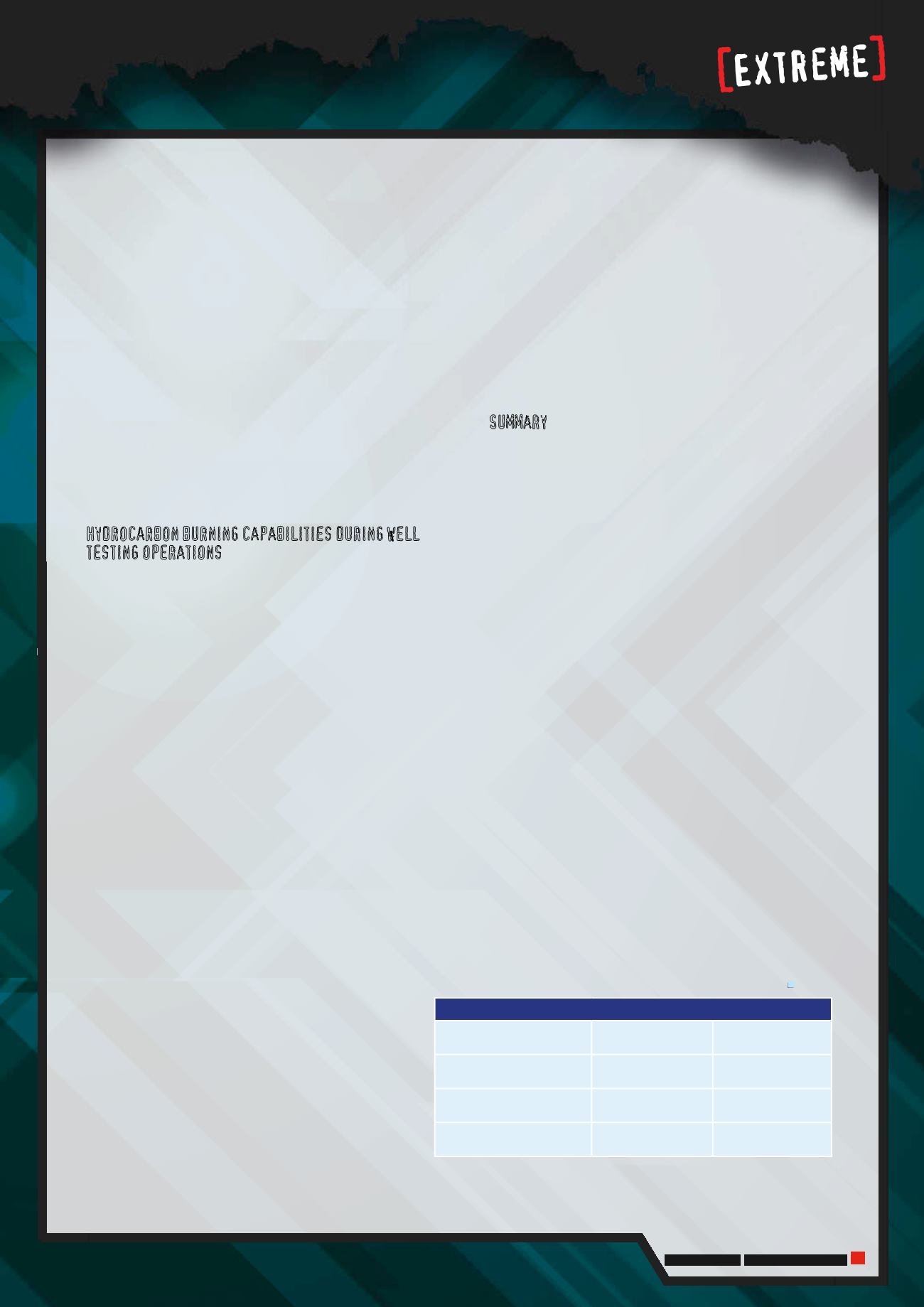
January 2016
Oilfield Technology |
65
Table 1. Performance characteristics.
Fallout efficiency target testing
99.99952%
Based on fallout
target testing
Combustion efficiency (Carbon
Converted into CO
2
+ CO)
99.4%
Reference EPA-600/2-
83-052
Destruction efficiency (Carbon
Converted into CO
2
+ CO)
99.5%
Reference EPA-600/2-
83-052
Carbon dioxide emissions
41 Ib CO
2
/MMBtu
Reference EPA-
453/R-11-002 & AP 42
collaboration and decision-making tool to engineers to
facilitate/optimise the entire test process.
In addition, access to real time data helps avoid
situations sometimes common in the past, when
non-conclusive test results were achieved because only
memory gauge technology was available and access to
data for reservoir interpretation was only possible after
the conclusion of the test. The same concept is applicable
to the sampling operation, since in the past no assurance
of samples being collected or type of fluid collected by
samplers during testing was available during execution of the
test. This information can now be confirmed and validated
with the application of acoustic technology using real time
capabilities (Figure 6).
Hydrocarbonburningcapabilities duringwell
testingoperations
Another critical challenge in deepwater environments is the
efficient burning of hydrocarbons. As part of the well tests,
a significant amount of hydrocarbons reach the surface and
need to be disposed of by burning or ‘flaring’. The design
of burners is generally the result of a configuration for very
specific work conditions. In ecologically sensitive areas
where it is critical to quantify produced emissions and
eliminate fall outs, an environmentally distinctive burner
(Figure 6) should be used.
The burner has been extensively tested, qualified, and
certified to be the first in the industry to comply with the
performance characteristics shown in Table 1.
The innovation in this critical area of deepwater
testing comes from following design features:
Nozzle control: This nozzle was designed to precisely
control the flow of oil and air through the burner and
allows the nozzle to be closed without any unburned
oil.
Cross lighting: The nozzles are arranged in a vertical
form to reduce the severity of radiant heat on the rig.
Careful overlapping allows effective cross lighting
independent of wind conditions.
Rotation: The burner head rotates 30˚ in either
direction from the centre in 15˚ increments. The
burner head is able to rotate while in operation.
Burner management system: A programme allows
individual opening or closing of nozzles to adjust
flow rates, drip-free shutdowns by pushing a single
button within 0.3 seconds, and the rotation of the
burner head for changing wind conditions (±30˚).
Remote operator interface: A real time control system
allows total control of the entire burner operations.
Dual ignition system: Real time provision of status of
ignition and flame detection device.
Combustion air utilisation for the pneumatic system: Use
of an accumulator tank that is fitted to store pressurised
air allows for sufficient air availability to close the burner
in cases where the air supply is completely lost.
System over-temp safeguards: All systems are heat
shielded.
Summary
The development of key technologies to operate under
harsh and challenging testing environments has achieved
the objective of accurately characterising reservoirs
and production potential in different environments
such as high pressure, deepwater and ultra-deepwater.
New technologies allow operators to accurately acquire
dynamic reservoir data, efficiently control downhole tools
and fluid samplers, efficiently and environmentally flare
hydrocarbons during testing of the well, and operate in a
collaborative environment allowing optimisation of the
well test. The efficiency is achieved through immediate
access to data, allowing accurate decisions so operators
can meet well test objectives and save rig time.
One of the key technologies for deepwater operations
is the application of the wireless telemetry system that
provides the ability for operators to have full tool acoustic
actuation and tool control. This delivers the statuses of
the downhole tools in real time together with bottomhole
pressure and temperature data. The system allows
complete verification of downhole testing operations
leading to reduced uncertainties.
In summary, the operators in the current market
environment have complete access to innovative tools that
allow them to operate in challenging environments, under
a broad range of well conditions from ultra-high downhole
pressure to ultra-deepwater with the ability to monitor
the events that are happening downhole. The wireless
acoustic system allows the operator to monitor, control,
measure, and analyse the entire well testing operation and
gain a clear understanding of reservoir conditions.


